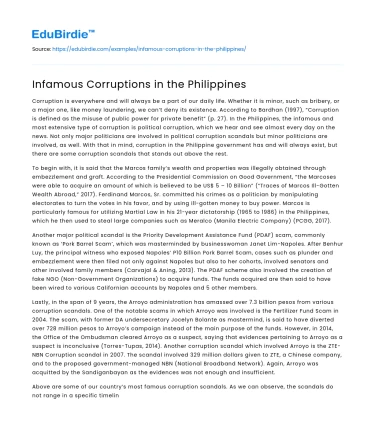Corruption is everywhere and will always be a part of our daily life. Whether it is minor, such as bribery, or a major one, like money laundering, we can’t deny its existence. According to Bardhan (1997), “Corruption is defined as the misuse of public power for private benefit” (p. 27). In the Philippines, the infamous and most extensive type of corruption is political corruption, which we hear and see almost every day on the news. Not only major politicians are involved in political corruption scandals but minor politicians are involved, as well. With that in mind, corruption in the Philippine government has and will always exist, but there are some corruption scandals that stands out above the rest.
To begin with, it is said that the Marcos family’s wealth and properties was illegally obtained through embezzlement and graft. According to the Presidential Commission on Good Government, “the Marcoses were able to acquire an amount of which is believed to be US$ 5 – 10 Billion” (“Traces of Marcos Ill-Gotten Wealth Abroad,” 2017). Ferdinand Marcos, Sr. committed his crimes as a politician by manipulating electorates to turn the votes in his favor, and by using ill-gotten money to buy power. Marcos is particularly famous for utilizing Martial Law in his 21-year dictatorship (1965 to 1986) in the Philippines, which he then used to steal large companies such as Meralco (Manila Electric Company) (PCGG, 2017).
Save your time!
We can take care of your essay
- Proper editing and formatting
- Free revision, title page, and bibliography
- Flexible prices and money-back guarantee
Another major political scandal is the Priority Development Assistance Fund (PDAF) scam, commonly known as ‘Pork Barrel Scam’, which was masterminded by businesswoman Janet Lim-Napoles. After Benhur Luy, the principal witness who exposed Napoles’ P10 Billion Pork Barrel Scam, cases such as plunder and embezzlement were then filed not only against Napoles but also to her cohorts, involved senators and other involved family members (Carvajal & Aning, 2013). The PDAF scheme also involved the creation of fake NGO (Non-Government Organizations) to acquire funds. The funds acquired are then said to have been wired to various Californian accounts by Napoles and 5 other members.
Lastly, in the span of 9 years, the Arroyo administration has amassed over 7.3 billion pesos from various corruption scandals. One of the notable scams in which Arroyo was involved is the Fertilizer Fund Scam in 2004. The scam, with former DA undersecretary Jocelyn Bolante as mastermind, is said to have diverted over 728 million pesos to Arroyo’s campaign instead of the main purpose of the funds. However, in 2014, the Office of the Ombudsman cleared Arroyo as a suspect, saying that evidences pertaining to Arroyo as a suspect is inconclusive (Torres-Tupas, 2014). Another corruption scandal which involved Arroyo is the ZTE-NBN Corruption scandal in 2007. The scandal involved 329 million dollars given to ZTE, a Chinese company, and to the proposed government-managed NBN (National Broadband Network). Again, Arroyo was acquitted by the Sandiganbayan as the evidences was not enough and insufficient.
Above are some of our country’s most famous corruption scandals. As we can observe, the scandals do not range in a specific timeline alone. Conclusively, corruption exists at all times, and some even go unnoticed by us, except for the people involved.






 Stuck on your essay?
Stuck on your essay?

